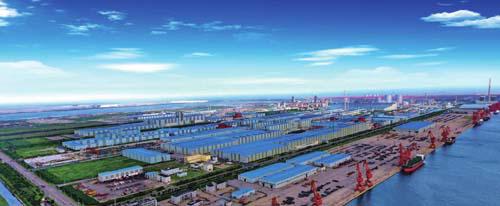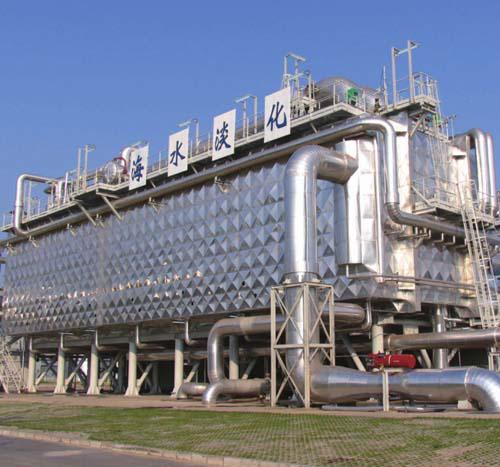Moving on Up
2018-08-24ByLuYan
By Lu Yan
Around 200 km away from Beijing, Caofeidian used to be a sandy island 8 km long and less than 600 meters wide. In 2003, a highway that would run through the island in the Bohai Sea began construction. Following its completion, a blowing land reclamation project was begun, creating a 210-square-km piece of artifi cial island from the sea area. The site is where Shougang Jingtang Iron & Steel Co. Ltd. sits, making it the very fi rst iron and steel company with an annual output of over 1 million tons located by a port.
More importantly, Shougang Jingtang, established in October 2005 as a subsidiary of the Shougang Group, is essential in the Beijing-headquartered steelmakers green transformation efforts.
Born in 1919, state-owned Shougang was one of the most important contributors to the increase of Beijings industrial capacity. However, after the citys successful bid for hosting the 2008 Summer Olympics in 2001, its pollution issue attracted a lot of attention, and the steel giant faced unprecedented pressure, despite its past efforts in environmental protection.
Shougang started looking across the country for another base location to solve the problem. Subsequently, the winner was Caofeidian, an economic development zone in the eponymous district of Tangshan in Beijings neighboring Hebei Province. After careful planning, Shougang began the relocation of its steelmaking capacity in February 2005, which was approved by the National Development and Reform Commission. Eight months later, Shougang Jingtang was inaugurated. In 2010, the new company completed its fi rst phase of construction and began operations.
“Since the relocation, we have fully tapped into advantages at the new base and have striven to upgrade our technology and pursue cyclic development,” said Ren Quanxuan, deputy head of Shougang Jingtangs Culture Department.
Forging ahead
In front of Caofeidian Island theres an icefree deep pool—the deepest point of the Bohai Bay—with a maximum depth of 36 meters. Moreover, theres a natural water- course with a maximum water depth of 27 meters connecting to the Yellow Sea that allows 250,000 tonners to travel through the Bohai Gulf.
According to Ren, with such a favorable location, Shougang Jingtang manages to import raw materials and export its end products through the port. “We have raised our market competitiveness since our transportation cost decreased to a great extent,” he told Beijing Review.
Since the relocation, the steelmaker has focused on upgrading the variety and quality of its products, with more high value-added and hi-tech products developed. Last year, the companys output of high-end iron and steel sheets and plates exceeded 3 million tons. Currently it holds the largest domestic market share in wheel steel and home appliance plates. Even during a depression of the iron and steel industry in 2015, the company managed to run without a loss, according to Ren.
With such a transformation, the company has been making steady progress, which not only shows in productivity, but also in envi-ronmental protection. Sea water desalination is one of the major parts of its cyclic development model. With four desalination plants—two of which were independently developed by the company—a total of 50,000 tons of fresh water can be generated. Based on the companys statistics, around 19.93 million tons of surface water can be conserved every year.
Waste residue, water and gas are recycled to a great extent. Strong brine left from the desalination is offered to a neighboring chemical enterprise. Slags are fi nely grounded and used for cement production. Exhaust gas is treated as a material for power generation. In total, 7.6 billion yuan ($1.12 billion) was invested in environmental protection during the first phase of construction, accounting for 11.21 percent of the entire project investment.
“We are not just moving our factories, but also our culture and concepts, with great importance placed on ecological design. Its like drawing on a white paper. We want to start from a high standard,” Ren said.
The relocation of the steelmaker is also an important part of a major national strategy fi rst put forward by President Xi Jinping in February 2014, which calls for the synergetic development of the Beijing-Tianjin-Hebei region and the coordination and integration of the economic zones surrounding Beijing. Last year, Caofeidian signed 99 projects with Beijing and Tianjin enterprises with a total investment of over 130 billion yuan ($19 billion).
In July, Beijing unveiled an action plan for Beijing-Tianjin-Hebei coordinated development between 2018 and 2020, which said that the city will strengthen cooperation with Tianjin and Hebei to promote overall transformation and upgrading of regional industries. It also included a program to help accelerate the construction of projects such as the second phase of Shougang Jingtang in Caofeidian.
The door to progress
Shougang Jingtang is not the only one that took the opportunity of relocation to enhance itself. Beijing Toho Steeldoors Industry Co. Ltd., a China-Germany joint venture, also thrived as a green building material pioneer after it moved to Caofeidian.
With door and window production as its main business, the company has left its mark on many major buildings across the country such as the National Indoor Stadium, the National Convention Center and the National Swimming Center in Beijing and the Shanghai World Expo Exhibition and Convention Center.
Huo Yujia, general manager of the company, said that dramatic changes have taken place since its relocation in 2016. Similar to Shougang Jingtang, the upgrade in production is one of the evident benefi ts. Despite advanced equipment, a small factory area and rising rent in Beijing made it difficult for the company to increase input in research and development. Now that its plant area has expanded from 4,000 square meters in Beijing to 18,000 square meters in Caofeidian, more space is available for technological innovation.
“Back then our goal was to survive, but now here in Caofeidian we have left those worries behind and are concentrating on how to make progress and thrive,” Huo said. One of the major breakthroughs the com- pany has made is the development of a new type of energy-effi cient security door, which has helped the company restructure toward high-end products. Huo told Beijing Review that in the past, to achieve a 10-million-yuan($1.47 billion) annual output value, the company needed to produce 8,000 doors, while now with its hi-tech invention, the number decreased to 600.
“Moving to Caofeidian was the right choice,” Huo said. In addition, the local government provided services and support to make the relocation process as smooth as possible, especially in terms of simplifying administrative procedures. From the signing of the move-in contract to the start of operations, it only took under 100 days. Moreover, with the help of Caofeidian authorities, the company got a special fund for technological innovation.
In the coming four to five years, the company will try to build itself into Chinas leading listed company focusing on hi-tech and green security building products. It is also working on exporting its commodities to the rest of the world.
